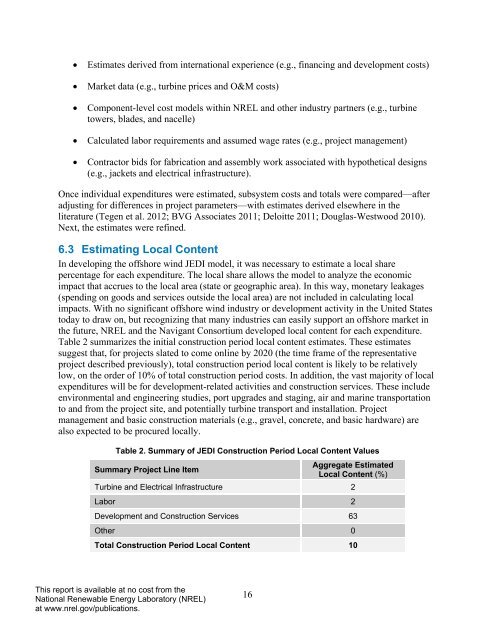(JEDI) Model: Offshore Wind User Reference Guide - NREL
(JEDI) Model: Offshore Wind User Reference Guide - NREL
(JEDI) Model: Offshore Wind User Reference Guide - NREL
You also want an ePaper? Increase the reach of your titles
YUMPU automatically turns print PDFs into web optimized ePapers that Google loves.
• Estimates derived from international experience (e.g., financing and development costs)<br />
• Market data (e.g., turbine prices and O&M costs)<br />
• Component-level cost models within <strong>NREL</strong> and other industry partners (e.g., turbine<br />
towers, blades, and nacelle)<br />
• Calculated labor requirements and assumed wage rates (e.g., project management)<br />
• Contractor bids for fabrication and assembly work associated with hypothetical designs<br />
(e.g., jackets and electrical infrastructure).<br />
Once individual expenditures were estimated, subsystem costs and totals were compared—after<br />
adjusting for differences in project parameters—with estimates derived elsewhere in the<br />
literature (Tegen et al. 2012; BVG Associates 2011; Deloitte 2011; Douglas-Westwood 2010).<br />
Next, the estimates were refined.<br />
6.3 Estimating Local Content<br />
In developing the offshore wind <strong>JEDI</strong> model, it was necessary to estimate a local share<br />
percentage for each expenditure. The local share allows the model to analyze the economic<br />
impact that accrues to the local area (state or geographic area). In this way, monetary leakages<br />
(spending on goods and services outside the local area) are not included in calculating local<br />
impacts. With no significant offshore wind industry or development activity in the United States<br />
today to draw on, but recognizing that many industries can easily support an offshore market in<br />
the future, <strong>NREL</strong> and the Navigant Consortium developed local content for each expenditure.<br />
Table 2 summarizes the initial construction period local content estimates. These estimates<br />
suggest that, for projects slated to come online by 2020 (the time frame of the representative<br />
project described previously), total construction period local content is likely to be relatively<br />
low, on the order of 10% of total construction period costs. In addition, the vast majority of local<br />
expenditures will be for development-related activities and construction services. These include<br />
environmental and engineering studies, port upgrades and staging, air and marine transportation<br />
to and from the project site, and potentially turbine transport and installation. Project<br />
management and basic construction materials (e.g., gravel, concrete, and basic hardware) are<br />
also expected to be procured locally.<br />
Table 2. Summary of <strong>JEDI</strong> Construction Period Local Content Values<br />
Summary Project Line Item<br />
Aggregate Estimated<br />
Local Content (%)<br />
Turbine and Electrical Infrastructure 2<br />
Labor 2<br />
Development and Construction Services 63<br />
Other 0<br />
Total Construction Period Local Content 10<br />
This report is available at no cost from the<br />
National Renewable Energy Laboratory (<strong>NREL</strong>)<br />
at www.nrel.gov/publications.<br />
16
















